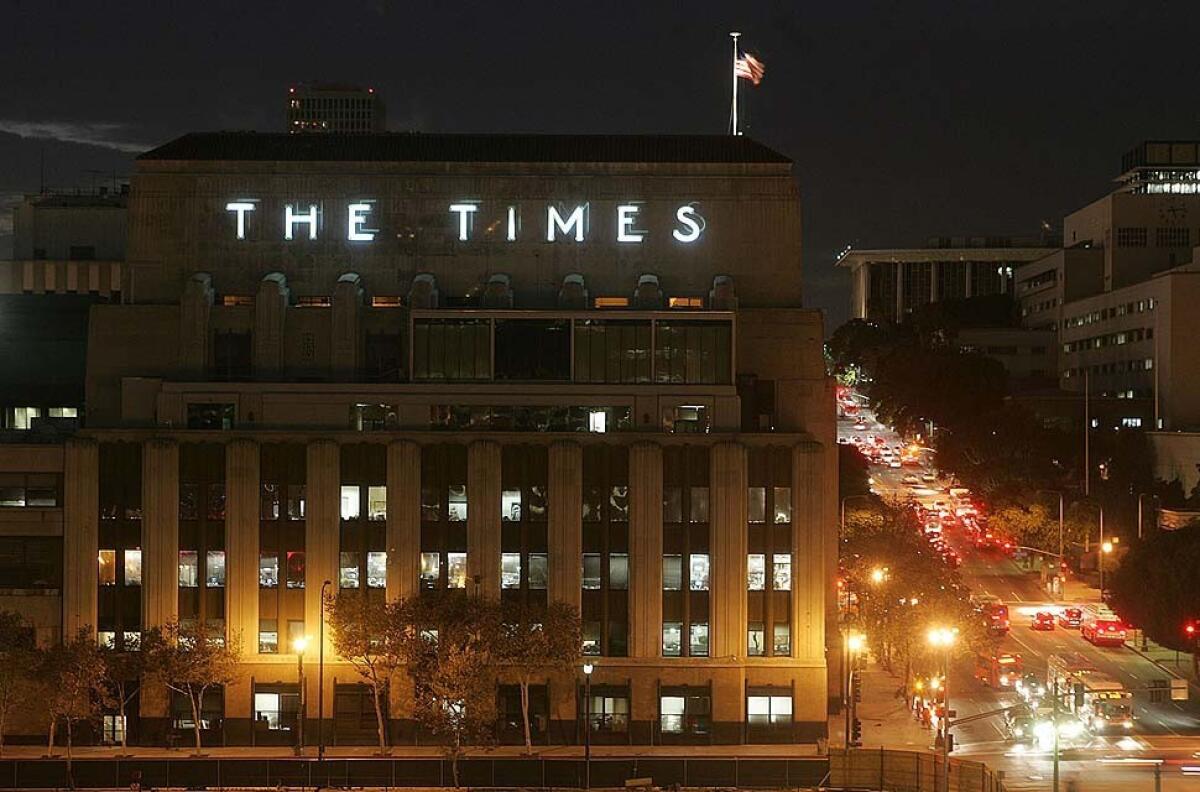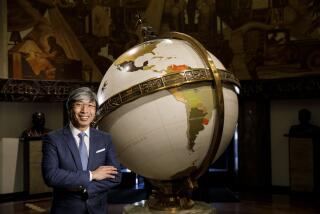L.A. Times editor reflects on year in journalism

A memo to the newsroom from Times Editor Davan Maharaj:
As we embark on a new year, I want to take a moment to review the exceptional work you produced in 2013, and offer my heartfelt thanks for it.
We started the year with two ambitious goals: to make significant strides in our digital journalism and to continue the distinguished investigative and enterprise work that has long been a hallmark of The Times.
These are the pillars of our future, and all of you delivered: reporters and critics, photo and video journalists, editors on the assigning and copy desks, page designers, artists, producers, data journalists and researchers.
Throughout 2013, we continued to set the agenda for our region. Readers noticed. One recent letter writer put it this way: “With the resignations last week of Department of Water and Power chief Ron Nichols and Sheriff Lee Baca, I believe the city and county of Los Angeles have stumbled upon their oversight committee: the Los Angeles Times.”
Here are a few (but only a few) of the highlights:
Our relentless coverage of the Los Angeles County Sheriff’s Department culminated in criminal indictments -- and Sheriff Lee Baca’s stunning announcement last week that he will step down.
On that and other running stories, our Metro colleagues gave real meaning to the phrase “shoe-leather reporting.” They spent months poring over building records and walking the streets of L.A. to identify dozens of substandard concrete structures at risk of catastrophic collapse during an earthquake. They showed how city officials had approved major new developments on or near active faults. In response, officials acknowledged the gaps in regulation and took steps to close them.
Exploring the world of private foster care agencies, we uncovered widespread child neglect and abuse, prompting corrective action by embarrassed officials. At the city Department of Water and Power, we exposed jaw-dropping examples of waste and patronage.
The Times litigated for years to gain access to the L.A. archdiocese’s voluminous secret files on pedophile priests. When the records were made public last year, we mined them for a series of powerful stories that showed how church leaders had covered up the problem and shielded abusers from prosecution.
At City Hall, Metro mobilized a formidable team of reporters and data journalists for the mayor’s election. The result was an agenda-setting combination of political reporting, investigative work and big data.
Times reporters continued the paper’s distinguished tradition of long-form narrative writing with powerful portraits of returning war veterans, a gripping reconstruction of former LAPD Officer Christopher Dorner’s murderous rampage, and sparkling profiles of a trauma surgeon, a wise-beyond-his-years autistic teenager and a 94-year-old mountain man, among others.
Business News reporters showed how big insurers and the NFL persuaded the California Legislature to shut the door on former athletes seeking compensation for disabling injuries. They also exposed the abusive sales practices that lay behind Wells Fargo & Co.’s success at “cross-selling” financial services to its customers.
In late 2013, Obamacare’s health insurance exchanges opened for business, and consumers struggled to make sense of it all. In a minefield of complications, we offered plain-spoken explanations and held government and industry accountable.
The National staff kept The Times at the forefront of some of the year’s biggest breaking stories. In Boston after the marathon bombing, national reporters mounted a night-long effort that brought readers the real-time drama of the police shootout with the Tsarnaev brothers -- reporting developments a full hour ahead of the New York Times through much of the night. Wall-to-wall coverage of the George Zimmerman trial -- including first-out-of-the-block coverage of the verdict -- drove hundreds of thousands of readers to latimes.com.
National correspondents introduced readers to undiscovered places and unforgettable characters –a cross-dresser named Sissy in Wyoming’s cowboy country, a vegan stripper in Portland who tweeted with a politician, the communal waterways of rural New Mexico, the all-night, drug-fueled party culture in New York City. They also reported with authority on the most important issues confronting the nation: the political stalemate in Washington, the advance of same-sex marriage, marijuana legalization and new limits on abortion.
On one of the most difficult international stories, the Foreign staff provided what few others could: a comprehensive view of the Syrian conflict from both sides. Correspondents also provided stellar coverage of an event with no parallel in the last 600 years -- the resignation of a pope -- and the surprise selection of the first leader of the Roman Catholic Church from the Americas. As Nelson Mandela’s health deteriorated during the year, we provided regular online updates and comprehensive stories full of rich detail and deep knowledge of South Africa. When Mandela died in early December, our obituary and related coverage were second to none.
In Egypt, our correspondents bravely covered the street fighting between security forces and protesters. In Afghanistan, they showed what the country would look like at the end of America’s longest war, and in Mexico City and Beijing, they illuminated the transition to a new generation of leadership in countries of vital interest to Southern California readers.
Sports again demonstrated its dominance in Southern California, serving as the primary outlet for breaking news and analysis of all major teams and personalities in the region. Lane Kiffin’s early-morning firing as USC football coach was broken first on latimes.com, as was the news of longtime Lakers owner Jerry Buss’ death.
An in-depth enterprise package by Bill Plaschke focused on the 1988 Dodgers -- the last Dodgers team to win a World Series -- highlighted by a look at the memorable Kirk Gibson home run in Game 1 of the World Series through the eyes of three out-of-the-mainstream individuals.
The Calendar staff produced deeply reported stories examining accidents on reality TV sets and the ineffectual efforts to diversify the Motion Picture Academy. We explained how tax credits designed to lure location filming benefit wealthy individuals and big companies, how London is becoming the new Hollywood and how Ted Sarandos turned Netflix from a TV utility into a content provider.
We provided an in-depth look at the culture of violence in a special Sunday Calendar package and online as well. Similar packages looked at how the JFK assassination changed popular culture and how Disney Hall changed the L.A. arts scene.
Our critics took on violence against women in video games, identified shortcomings at Disney Hall and the Hollywood Bowl, and told readers how the ballyhooed “Pacific Standard Time” exhibits weren’t all they should have been.
Features scored big successes with “Postcards From the West,” a series of Travel section stories on iconic sights, and with a rebooted Image section that runs twice a month at 12 pages. In Books, print, visual and digital journalists collaborated on the interactive L.A. literary map, which debuted in time for the L.A. Times Festival of Books.
Editors and writers in Food saw an enormous jump in traffic for the Daily Dish blog. And they worked closely with the Data Team to produce the California Cookbook recipe database and the Gold 101 compendium of Jonathan Gold restaurant reviews. Maps for the 101, best Mexican restaurants, great L.A. bakeries and other food topics delivered our coverage in new formats.
That brings us full circle. 2013 was a year when digital and print came together in important and lasting ways. We saw growth in traffic and in real-time news coverage. Times journalists harnessed the power of social media more effectively than ever. Several of our top writers made a successful leap into digital, developing national followings as voices of opinion and commentary. Homepage producers began hand-coding our Column Ones in March, greatly improving the presentation and helping to triple the audience to some of our best storytelling. We put a full-time reporter on The Homicide Report-- which is getting a major upgrade this weekend -- a sign that we are recommitting to one of our marquee public service projects.
Expect this digital revolution to continue in 2014. We have more training planned and a long list of projects in the works.
And if you want to see why we do it, here’s my favorite reader response this year.
Thanks again for an amazing year. I’m looking forward to another year of inspiring work in 2014.




